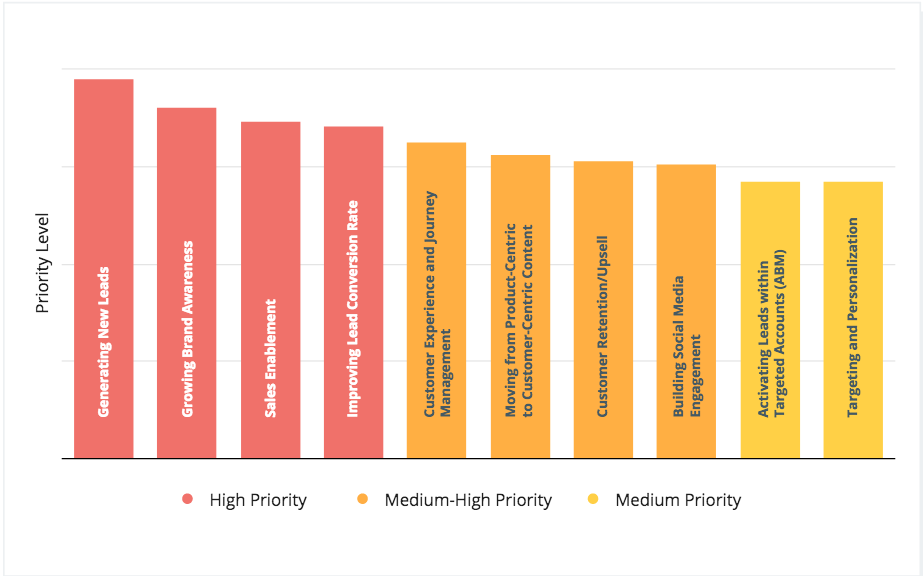In our 2017 B2B Content Strategy and Operations Benchmark, we found an interesting trend in what marketers chose as their top B2B marketing priorities: all of them.

B2B marketers are struggling with prioritization. When presented with a list of priorities, only 17% of marketers were able to name anything on the list as their lowest priority.
Well, we can’t prioritize everything at once; we’d never accomplish anything. You might make two inches of headway on some of them, but that won’t give you the impact you were hoping for.
So what should really be the highest priorities for your B2B organization?
In her post, “The Stats Your Content Operation Strategy Needs,” Ardath Albee presents what may seem like a counterintuitive solution: go for what you think are the lower priorities first.
Before you start interjecting with cries of, “Lead generation!” and “Sale enablement!”—hear me out. You have to think of your priorities like the foundation of your house: in order to have a beautiful, robust building, you need to have the less aesthetically appealing, underground portion that supports the entire structure. That’s what priorities like tagging, taxonomy, and building in-depth personas become: your foundation.
As Ardath writes,
[W]hat if our content operations strategy was to start checking those lesser priorities off as a means to achieving our highest priorities? What you’ll find is that you’ll achieve a continuous improvement cycle that sweeps other priorities up as you gain momentum.
If you focus on the more tactical priorities that support the larger goals, those beautiful higher aspirations will naturally follow.
We’ve identified a three key directions that best-in-class marketers are homing in on that build momentum across their lower priorities and achieve their top priorities in record time.
1. Aim for Customer-Centric to Generate Leads
Living in the Age of the Customer means that we need to think strategically and carefully about how we talk to our consumers. B2B marketing organizations are making the move toward customer-centric strategies, with just over 53% of content built to satisfy and engage the customer throughout his or her sales journey.
But how can we do better?
Let Your Audience Guide You
An audience-centric strategy is more than just a buzzword. Research has shown that when you focus on your buyers—their pain points, their interests, their budgets—you’re more likely to convert sales opportunities and retain customers. But it’s not just about making your customer happy. A true customer-centric strategy focuses on cultivating relationships. AMA has delineated its seven pillars of customer-centricity as:
- Experience
- Loyalty
- Communications
- Assortment
- Promotion
- Price
- Feedback
The main idea behind each of the above is to build a partnership with your customer to achieve both of your goals: remedy a pain point for them and sell your wares for you. When you create content with this goal in mind, you will generate better-qualified leads that feel loyalty to—and become advocates for—your brand.
Build a Robust Persona Scaffold
The first step in writing content for a specific audience is knowing who that audience is. Take the time to establish whom your product or service really satisfies.
This post outlines the key steps to build in-depth B2B personas:
- Conduct internal interviews to establish how your organization understands its customers
- Conduct external interviews with customers and buyers to collect direct information
- Perform further external research through social media and blogs
- Condense your research
Find more details about the questions to ask in persona interviews, the places to conduct research, and the types of formats in which the material can be collected in the full article.
Create Personalized Content
Personalizing your content to suit your target audience not only helps you to drive sales by providing leads already well-educated in your product, it also helps you learn more about your intended market. In order to create content that resonates, you have to test what you’re putting out there.
Read more on capitalizing on personalization through multiple channels.
2. Aim for ABM to Enable Sales
The days of cold calling are over. Now, buyers complete over half of their sales journey digitally. What’s more, if you want to get the top companies, you can’t just market directly to the executive—they’re not reading your blog or social posts. But you can reach the people advising them.
Talk to the People Who Will Talk to the Big Wigs
The people you really want to be aware of your product or service—the executives who have the final say in a purchase—are just the people who don’t have the time to read through all your carefully built content. So how do you reach that audience?
Operations and production teams are constantly scouring the web for resources. Make sure you’re talking to them so that they can talk to the people who have final buying approval. If you can get multiple levels of an organization on board with your services, they’ll do the work for you of convincing their higher-ups that yours is a product they need.
Understand When and Where You Need the Content
Tailoring your content to match where your audience is in their journey toward purchase is vital to enabling your sales team to do their jobs well. In this interactive infographic, SiriusDecisions not only outlines the major stages of the buyer’s journey but also gives insightful tips on what kind of content you should produce for each stage.
For example, concentrate on brand awareness for the buyers that are just beginning to think of the issues they’re facing. Speak to their pain points in blogs and social copy so that they know you have a solution for them. Work on standing out from your competitors so that you make it through the gauntlet of their research stage.
For customers that are at the decision stage, focus on content that helps them better understand and use your product. Get into the nitty-gritty details of what you can do for them with drip campaigns. And use their success with your product to promote your brand; get feedback and metrics from your successful customers to write case studies and testimonials to promote your brand and your product.
If You Build It…Make Sure They Can Find It
So you have a content operation in place, and everyone is writing first-rate assets and blog posts. Fabulous job! But all that means nothing if your sales team can’t find that perfect piece of content to show the prospect and land the lead.
It’s not enough to simply build the beautiful house—you need to make sure that you can navigate to it.
A content management system is a key tool not only to create content but also to enable your sales team to be able to find the content they need when they need it to make a sale. Here are the best CMS tools of 2017 to help you make a decision of what to use for your company.
You may also consider going one step further and investing in a full content operation system. With a single source of truth, you can create, organize, store, and distribute all your fabulous content at just the right time. If you’re concerned you may not be able to convince your boss to invest, we’ve got you covered—sample scripts and all.
Download the Building a Business Case for a Content Operation eBook to start making your marketing strategy that much better.
3. Aim for Optimization to Increase Brand Awareness
Let’s face it: no one is going to care how good your product is if no one knows about it. Make sure you’re presenting your best face to the world by creating a user-friendly website, posting regularly on blogs and social channels, and making sure that everyone who speaks for your company does so through one brand voice.
Give the People What They Want
All of us living in the digital age know that a vital aspect of brand awareness is optimizing your site with SEO.
But believe it or not, keywords may not be the best way to achieve a robust SEO strategy. What’s the secret to getting more people to visit your site, stay on your site longer, and thus, realize higher rankings in searches?
That’s right. Don’t just hash out a few 400-word blog posts every week and expect the crowds to come running. Some of the best types of content to publish to realize better traffic on your site (not just more—better) is to create long-form content and graphics. Produce webinars, videos, and infographics that keep people on your site longer. Research and write amazing white papers so your audience knows you’re a credible source. They’ll keep coming back for more. Which means you’ll gain higher visibility on the web and gain even more readers.
There’s a bonus, too: All of these higher production assets can become the pillars for derivative content. Make sure to write engaging social copy for all that you create to reach your audience where they live online.
Get the Right Tech
We’ve covered a lot of ground so far with all these “lower” priorities, so the best way to keep it all straight is to have the right tools to help you organize, produce, and implement the best strategy for your business. There are a million of SaaS and free options out there. We covered some in this post, including Salesforce for CRM, Optimizely for CRO, and HootSuite for brand management—we don’t like to toot our own horn (okay, yes we do, we’re marketers), but Kapost is the #1 choice for B2B content operations platforms around.
Write It All Down—No, Really, Do It
This is all well and good, but what will any of this work matter if you’re the only one who can do it? It may seem cumbersome or tedious, but creating and maintaining a healthy documented strategy is imperative for a successful content operation—or any operation, really. Documentation alleviates some of the pain associated with change management, and it allows for consistency throughout all forms of content—which, as we know, is key to a positive customer experience.
But it’s not just enough to know that you should do something; you have to know how best to do it.
Hubspot details how to document a content strategy in seven basic areas:
- Overall mission
- Target audience personas
- Content mix plan
- Content creation process
- Editorial calendar
- Distribution plan
- ROI calendar
Get started by writing down your strategy so that you can ensure your brand is heard accurately across all channels.
Final Thoughts
Improving on these less flashy, tactical priorities may not seem like it will get you very far. But with these elements in place, you’ll have the foundation you need to meet you bigger, more exciting goals.

